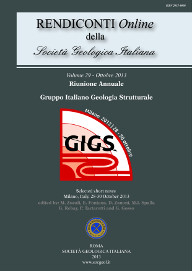
Study of the Early Jurassic Calcari Grigi carbonate platform (Southern Alps, Italy) integrating 3D-modeling and geostatistics
Marco Franceschi (a), Matteo Massironi (b), Pietro Franceschi (c) & Vincenzo Picotti (d)
(a) MUSE – Museo delle Scienze, Trento, Italy. Email: marco.franceschi@muse.it; marco.franceschi79@gmail.com
(b) Dipartimento di Geoscienze, Università degli Studi di Padova, Italy.
(c) Biostatistics and Data Management research group - Computational Biology, Research and Innovation Center, Fondazione Edmund Mach, San Michele all'Adige, Italy.
(d) Dipartimento di Scienze Biologiche, Geologiche ed Ambientali, Università degli Studi di Bologna, Bologna, Italy.
Volume: 29/2013
Pages: 59-62
Abstract
The Calcari Grigi carbonate platform (Southern Alps, Italy) (size ~100km x 100km, up to 400m thick) consists of several sub-environments (tidal flats, deep lagoons, oolitic shoals), now exhumed in the Southern Alps (Italy), a poorly deformed portion of the Mesozoic passive margin of Adria. Despite some alpine faulting and folding, lateral relationships between Jurassic units are still preserved. During Early Jurassic, the platform was affected by synsedimentary tectonics, testified by exposed structures, controlling sharp variations in the thickness of its units. Excellent outcrop continuity, extensive geological mapping and previous
studies provide a great wealth of field data that give the opportunity to produce a 3D model of a seismic-scale carbonate platform. 3D modeling was carried out with SKUA®. Main stratigraphic horizons and geometries of the sedimentary prisms were modeled. Spatial variability of the platform units’ thickness was studied with geostatistics to retrieve information about the arrangement of the Jurassic fault system that drove subsidence during the platform growth. This helped to estimate the position of main Jurassic faults and revealed an extensive orthorhombic fault-network at the platform scale. The 3D model can now be populated with facies information, derived from outcrop data and geologic maps, to evaluate the influence of tectonics on the depositional environments. The model of a carbonate platform of this size potentially represents a useful analogue for carbonate reservoirs and help the understanding of similar buried sedimentary body.
Keywords
Get Full Text